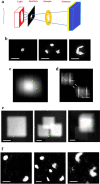Resolving hidden pixels beyond the resolution limit of projection imaging by square aperture
- PMID: 36859466
- PMCID: PMC9977726
- DOI: 10.1038/s41598-023-30516-z
Resolving hidden pixels beyond the resolution limit of projection imaging by square aperture
Abstract
Projection imaging has been employed widely in many areas, such as x-ray radiography, due to its penetration power and ballistic geometry of their paths. However, its resolution limit remains a major challenge, caused by the conflict of source intensity and source size associated with image blurriness. A simple yet robust scheme has been proposed here to solve the problem. An unconventional square aperture, rather than the usual circular beam, is constructed, which allows for the straightforward deciphering of a blurred spot, to unravel hundreds originally hidden pixels. With numerical verification and experimental demonstration, our proposal is expected to benefit multiple disciplines, not limited to x-ray imaging.
© 2023. The Author(s).
Conflict of interest statement
The authors declare no competing interests.
Figures



Similar articles
-
Effects of ray profile modeling on resolution recovery in clinical CT.Med Phys. 2014 Feb;41(2):021907. doi: 10.1118/1.4862510. Med Phys. 2014. PMID: 24506628
-
Improving small animal cone beam CT resolution by mitigating x-ray focal spot induced blurring via deconvolution.Phys Med Biol. 2022 Jun 8;67(12):10.1088/1361-6560/ac6b7a. doi: 10.1088/1361-6560/ac6b7a. Phys Med Biol. 2022. PMID: 35483338 Free PMC article.
-
Method for measuring the focal spot size of an x-ray tube using a coded aperture mask and a digital detector.Med Phys. 2011 Apr;38(4):2099-115. doi: 10.1118/1.3567503. Med Phys. 2011. PMID: 21626943
-
Optimization of the geometry and speed of a moving blocker system for cone-beam computed tomography scatter correction.Med Phys. 2017 Sep;44(9):e215-e229. doi: 10.1002/mp.12326. Med Phys. 2017. PMID: 28901608 Free PMC article.
-
Imaging properties of digital magnification radiography.Med Phys. 2006 Apr;33(4):984-96. doi: 10.1118/1.2174133. Med Phys. 2006. PMID: 16696475
References
-
- Müller B, Khimchenko A, Rodgers G, et al. X-ray imaging of human brain tissue down to the molecule level. Proc. XVII Int. Conf. X-ray Lasers. 2021;11886:1188613.
Grants and funding
LinkOut - more resources
Full Text Sources
Other Literature Sources

